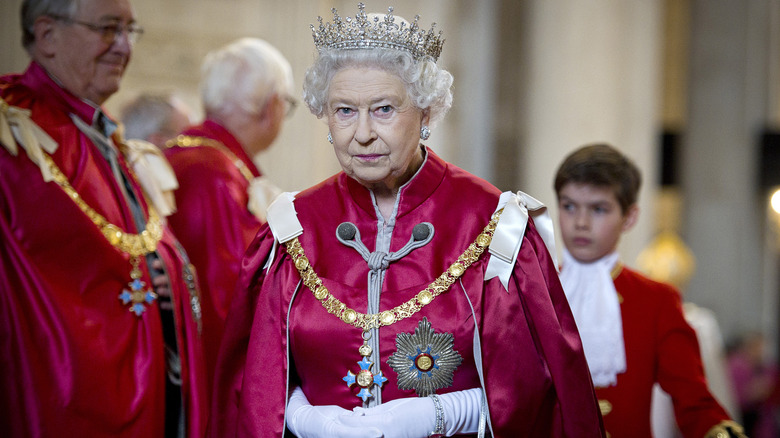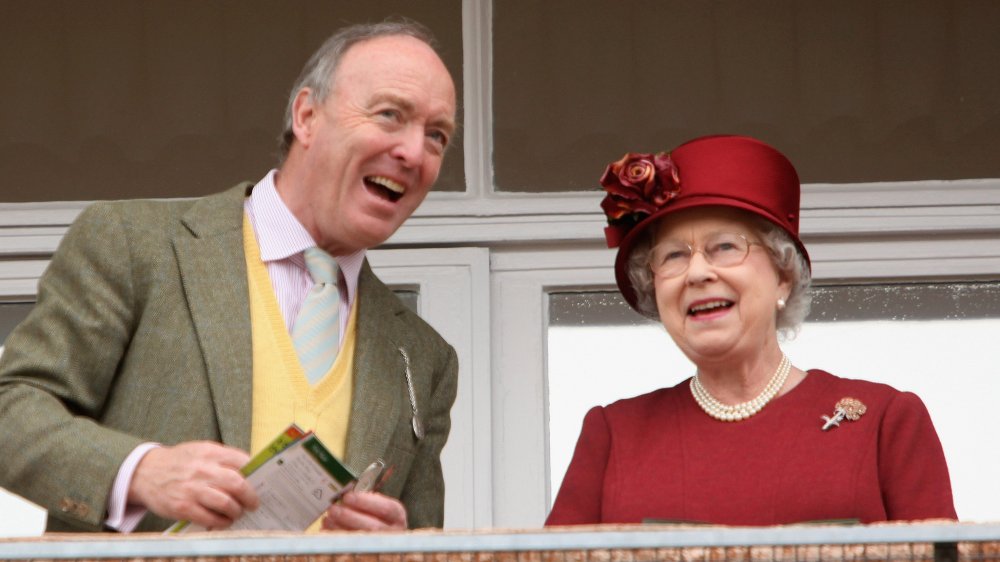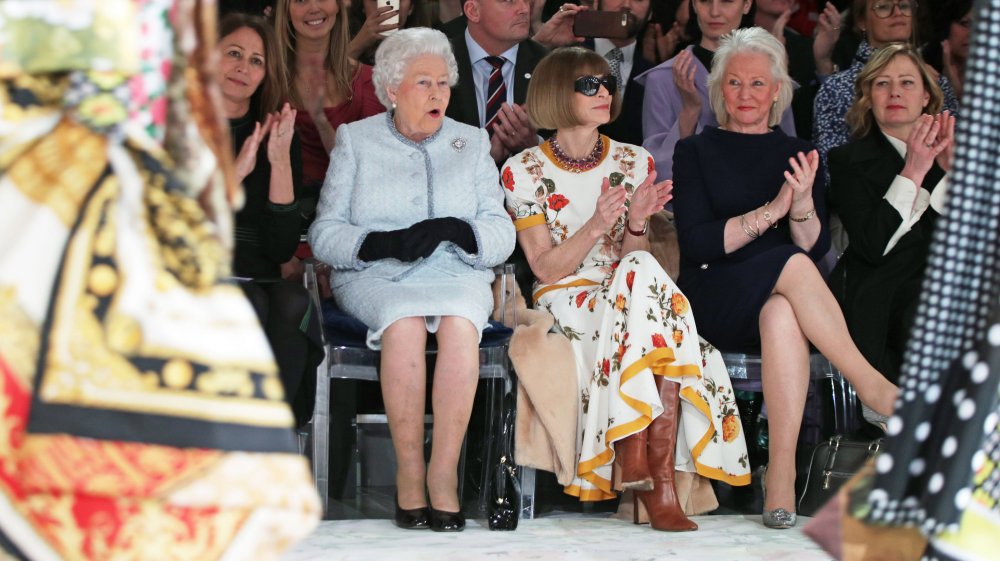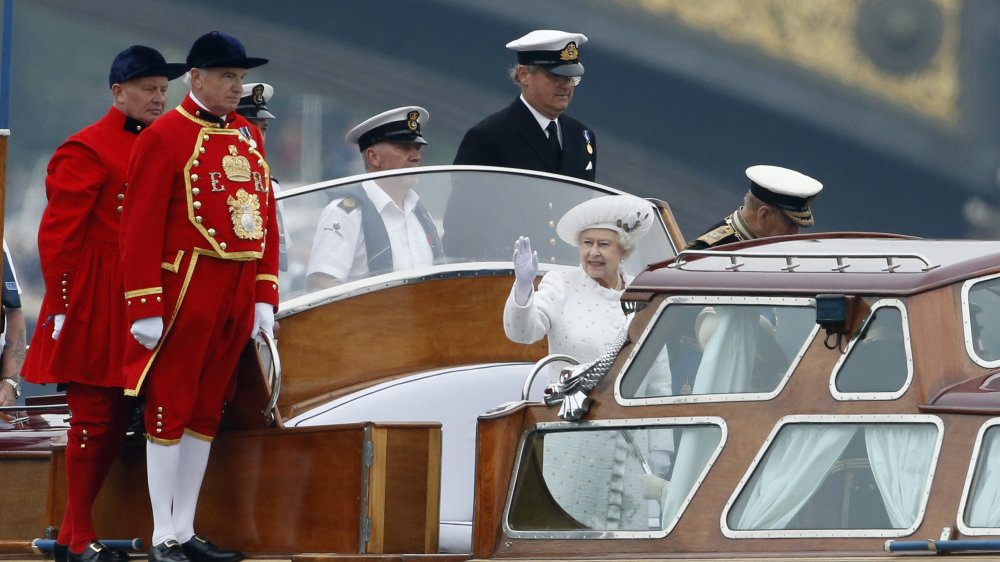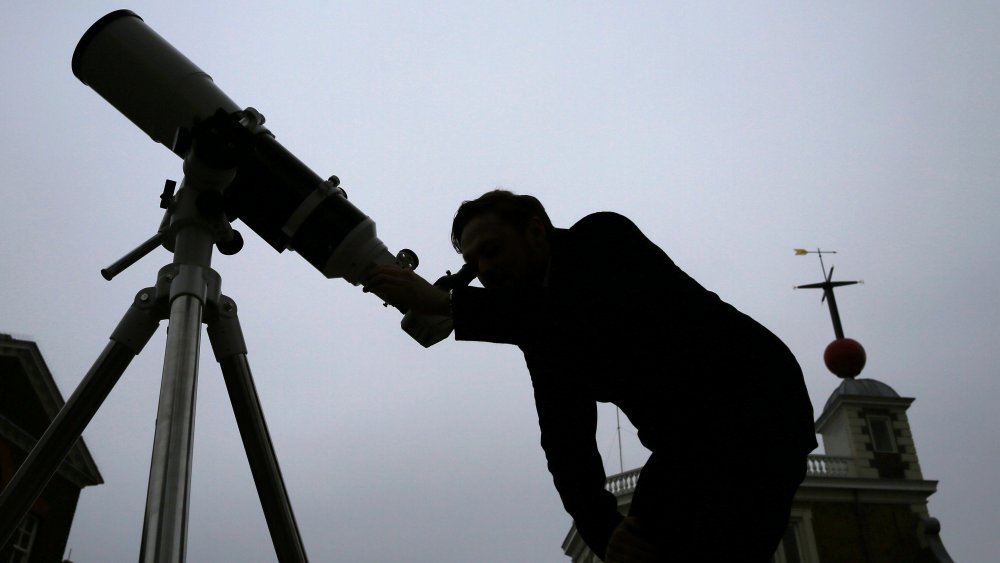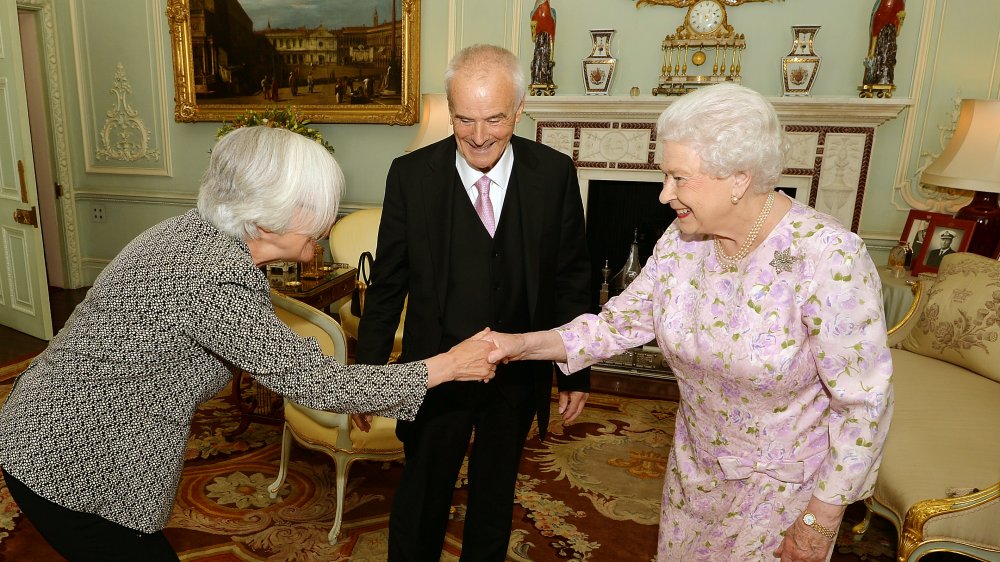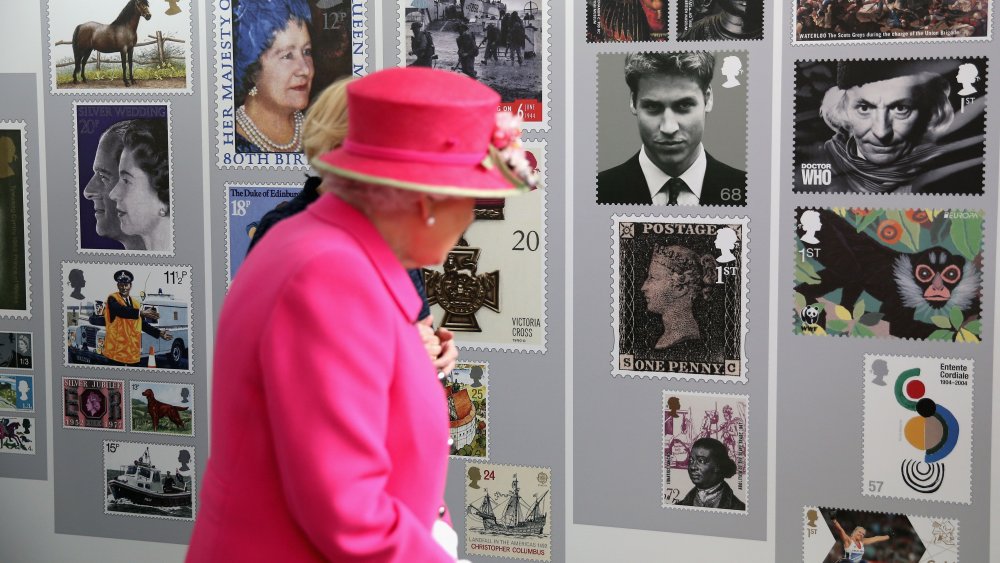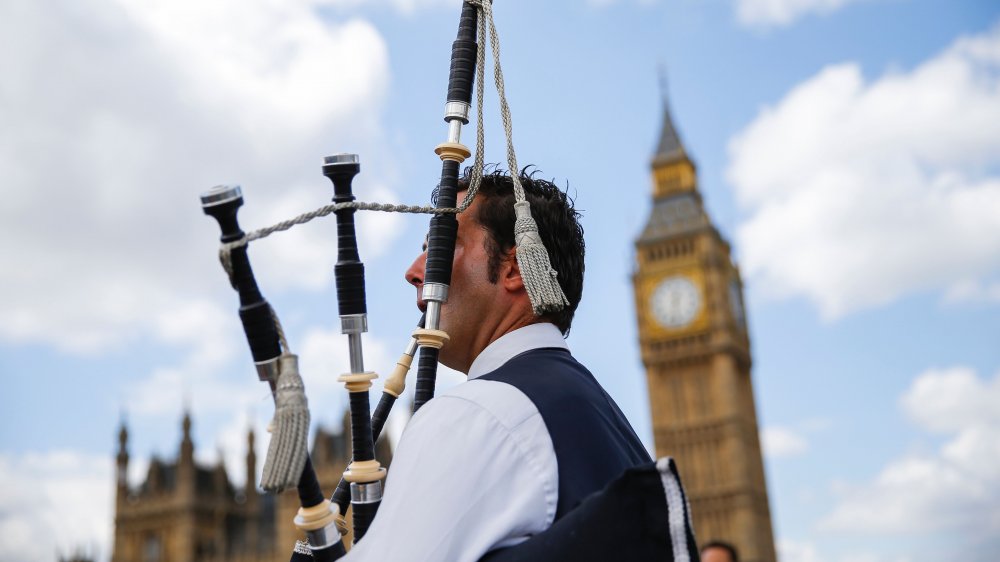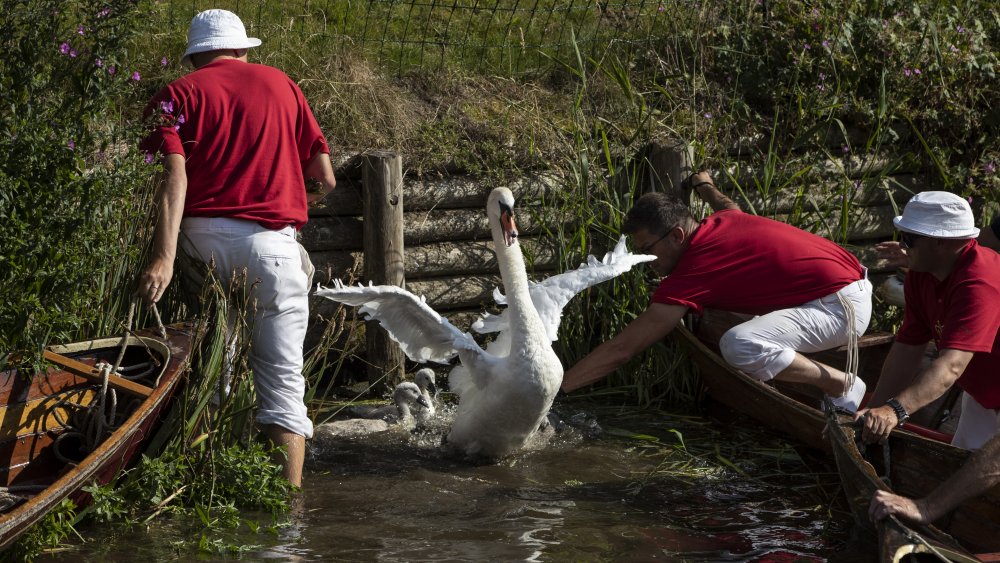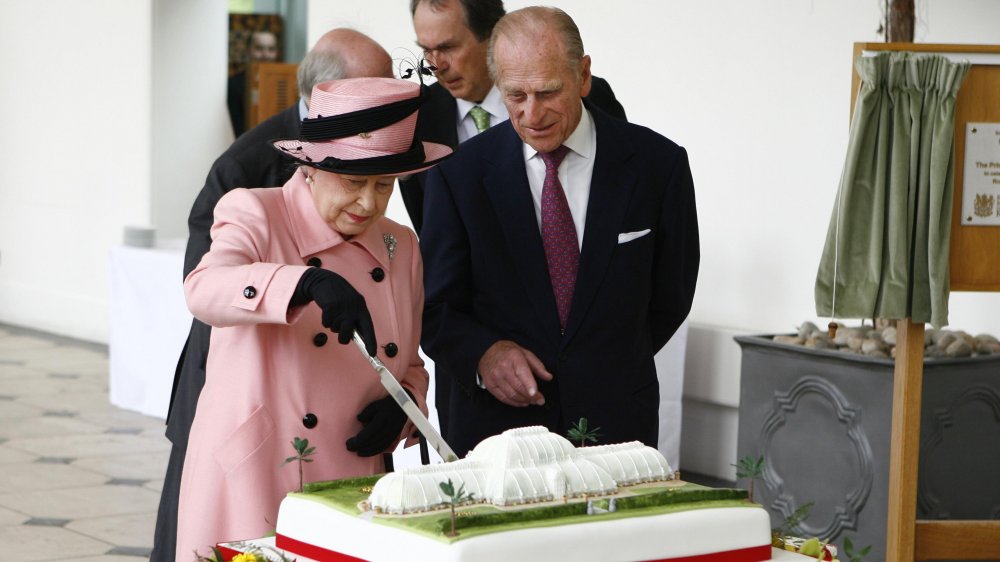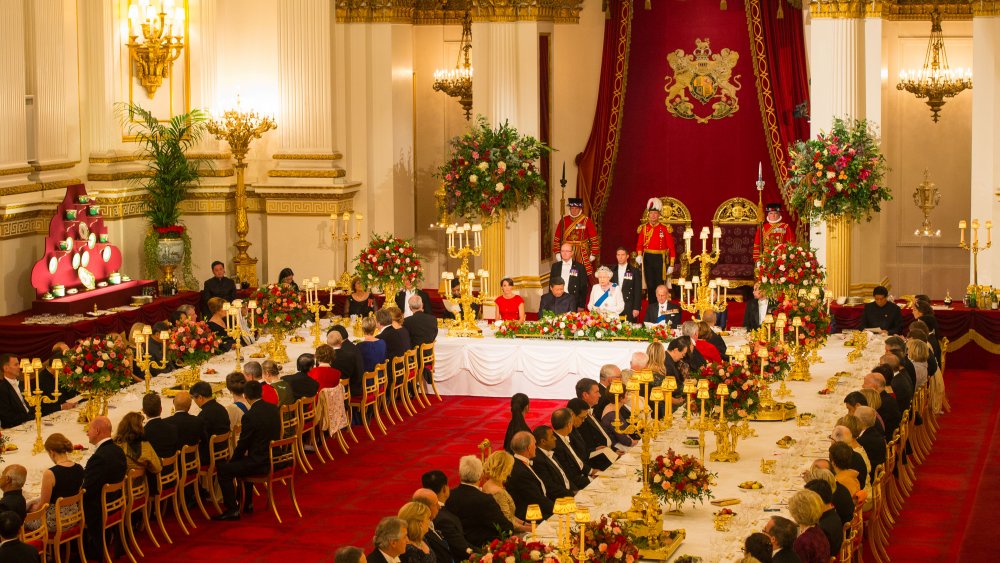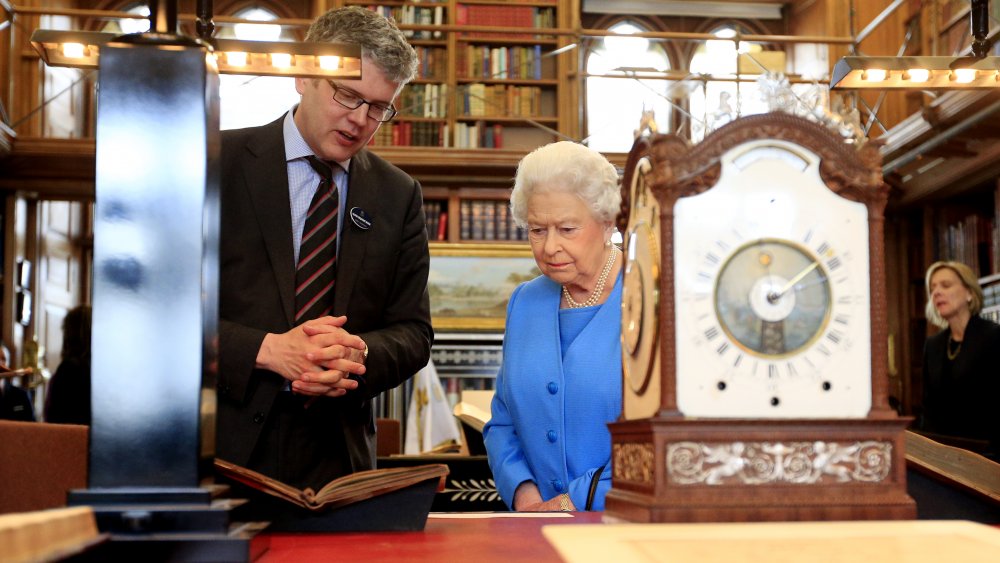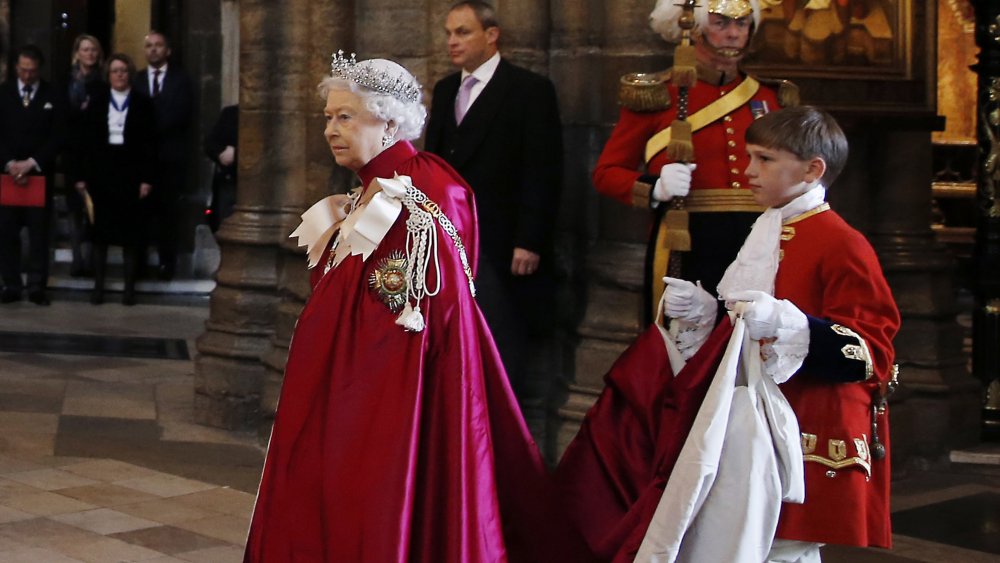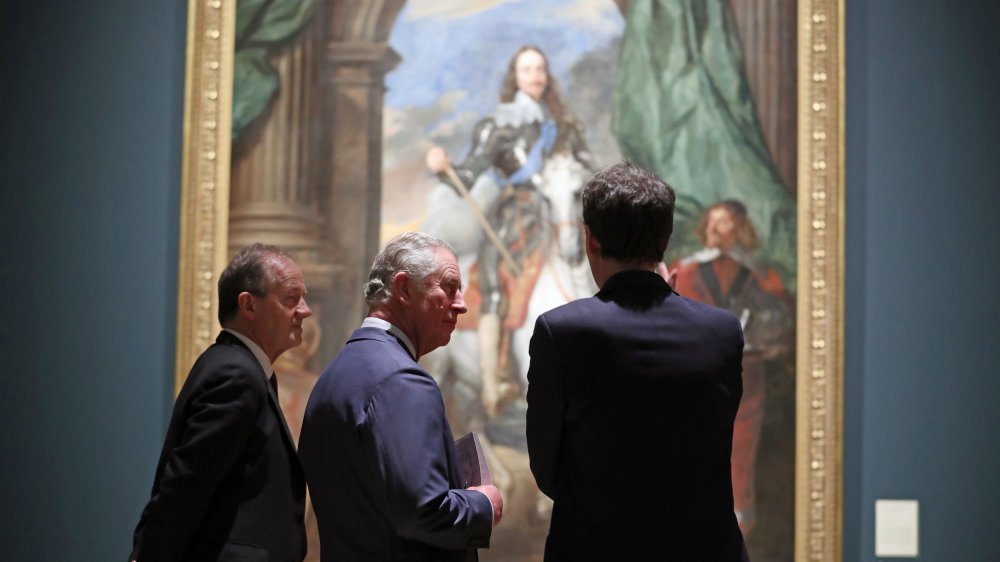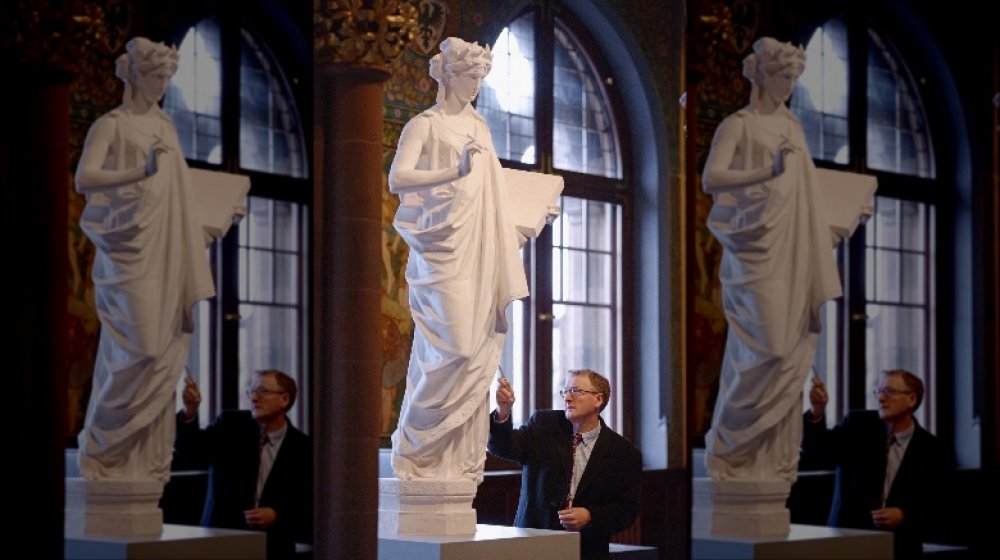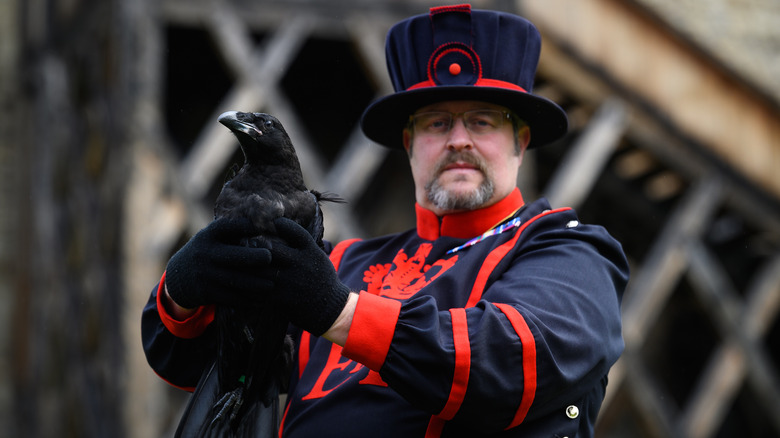Ridiculous Jobs Queen Elizabeth Has Her Staff Do
Queen Elizabeth II employs an astonishing 1,200 people just to keep the Royal Household up and running. The positions held by her staffers vary from cooks to chauffeurs and everything in between.
"One of the best things about working for the royal family is when you are recognized for your hard work," Grant Harrold, former butler to the Duke and Duchess of Cornwall, told Town & Country. "The family would show this by inviting staff to Christmas parties, tea parties, and balls. A fond memory of mine is getting to dance with the Queen at the Gillies Ball in the Balmoral ballroom." Nevertheless, working for the queen isn't all about dancing and enjoying tea parties.
Simon Morgan, a former royal protection officer, recalled working long days. "You are working for the world's number one family, and there is nowhere in the world they can go without being recognized," he continued. "That's your biggest pressure, anything that goes wrong has massive implications, which include the threat of life." Of course, not everyone holds high-stress positions. The queen employs quite a few people whose jobs are, well, a bit bizarre. These are some of the most ridiculous jobs within the Royal Household.
Master of the Horse
In the year 1340, the Master of the Horse position was created, Horse & Hound reported. While this position would've been of importance in centuries past, today the job is an honorary one. "The Master is no longer involved with the day-to-day running of [the Royal Mews] but still makes inspections and rides in ceremonial uniform at state occasions," the publication explained.
In 1999, Queen Elizabeth II appointed Lord Vestey, former chairman of Cheltenham racecourse in Gloucestershire, England, as the new Master of the Horse. As of this writing, Vestey continues to hold the ceremonial position. According to The Telegraph, he is "the senior officer" in charge of the royal stables (the Royal Mews) as well as the horses and horse carriages belonging to the queen. "In his role he attends important ceremonial occasions when the sovereign rides on horseback or travels in horse-drawn carriage, such as at Trooping the Colour and the state opening of Parliament," the publication explained. Yes, his job is to mostly just stand or ride beside the queen and her horse.
Shoe breaker
Stewart Parvin, the man responsible for Queen Elizabeth II's wardrobe, revealed a secret to the Evening Standard in 2017. According to him, a staffer is tasked with breaking in the queen's shoes. The Royal Household employee dons a pair of ankle socks and walks around the carpeted areas of Buckingham Palace. "The shoes have to be immediately comfortable...," he shared. "The Queen can never say 'I'm uncomfortable, I can't walk any more,'" he continued.
In her book The Other Side of the Coin: The Queen (via People), Angela Kelly, dressmaker to the queen, spilled more details about the strange practice. "As has been reported a lot in the press, a flunky wears in Her Majesty's shoes to ensure that they are comfortable and that she is always good to go," she revealed. "And yes, I am that flunky."
Although breaking in shoes is an untraditional request of a dressmaker, Kelly doesn't seem to mind. "The Queen has very little time to herself and not time to wear in her own shoes," she explained, "and as we share the same shoe size it makes the most sense this way."
Royal Watermen
Up until the mid-1800s, the head of the royal family traveled to and from the royal palaces via the river Thames. Back then, 48 staffers dubbed Royal Watermen were responsible for rowing the Royal Barges in order to transport the sovereign.
During King Edward VII's rule, he cut the number of watermen down to half. "The Sovereign today still retains 24 Royal Watermen under the command of The Queen's Bargemaster, thereby continuing one of the most ancient appointments in the Royal Household," the royal family's official site states.
While Queen Elizabeth II employs these 24 people, there are no barges in need of being manned daily. In the rare instance when the royal family travels on the Thames, the Royal Watermen are tasked with accompanying the family on the barge named the Royal Nore. Still, the site reveals that "the duties of the Royal Watermen are now purely ceremonial."
Astronomer Royal
One of the over a thousand people working for the longest-ruling monarch is the Astronomer Royal. This position first came to be in the 17th century. "The first Astronomer Royal, John Flamsteed, was charged by King Charles II with drawing up a map of the heavens with enough accuracy to be reliable for navigation," the Royal Museums Greenwich explained. Although this job, which was known as the King's Astronomical Observator at that time, led to a great number of scientific discoveries, the position is mostly ceremonial today. Still, the Astronomer Royal is in charge of "[advising] the Queen on astronomical matters," according to the museums.
As of this writing, astrophysicist Martin Rees holds the honorary position and is thus a member of the Royal Household. Being Queen Elizabeth II's astronomer isn't exactly a well-paying job, though. Rees receives a stipend of just £100 (about $129) per year.
Master of The Queen's Music
Queen Elizabeth II has her very own composer dubbed the Master of The Queen's Music. In the past, this position was a lifelong commitment. However, the royal family's official site states that the terms have been changed to ten years in order to "give more composers the opportunity to take up this honorary position." BBC News explained that there are "no fixed duties involved" with the title, but "the Master may compose pieces for Royal or State occasions."
While this is largely a ceremonial job today, those who've been appointed as Master are extremely talented. In 2004, the sovereign chose renowned British conductor and composer Sir Peter Maxwell Davies. He formerly worked as the conductor and composer for both the Royal Philharmonic Orchestra and the BBC Philharmonic. A decade later, the queen appointed the first-ever female Master of the Queen's Music, Judith Weir — a former opera writer and resident composer with the City of Birmingham Symphony Orchestra.
Keeper of the Royal Philatelic Collection
Keeper of the Royal Philatelic Collection has to be one of the oddest titles to hold. Appointed by Queen Elizabeth II, the Keeper is entrusted with maintaining her personal stamp collection. Before being chosen for this position in 2003, Michael Sefi, was already working for the royals as Deputy Keeper.
Upon his appointment, he provided some details about his new position. "The job as Keeper is part-time and the commitment is two days a week; my commitment to the British Philatelic Trust (a charitable educational trust which promotes the educational aspects of philately) is the same," he told The Times. "If one wanted to spend three, four, five, six, or even seven days a week in the Stamp Room, one could, as there is always lots to do."
There's a lot to do because the queen has a ton of stamps. "The red albums of King George V amount to around 17,500 album pages," Sefi revealed. "The blue albums of King George VI will also contain many thousands of album sheets." But that's good news for Sefi. "For a serious, dedicated philatelist it is a tremendous privilege," he said.
Piper of the Sovereign
Since 1843, during Queen Victoria's reign, the Royal Household has included the Piper of the Sovereign. This musician is "responsible for playing the bagpipes whenever Her Majesty requests it," according to Hello! magazine. Additionally, the piper is tasked with playing bagpipes every weekday for 15 minutes beginning at 9 a.m., which acts as a wakeup call for the queen. "The sound of the lone piper has played under the Queen's bedroom window every weekday since she took up her position on the throne," Express reported.
Although an alarm clock could arguably replace this wakeup call, Queen Elizabeth II continues to employ a Piper of the Sovereign. Since its inception, 16 people have held the position and only two breaks — one four-year pause during World War II and a weeks-long gap after Pipe Major Scott Methven unexpectedly left due to family reasons — have been observed.
As of this writing, Pipe Major David Rodgers holds the title — and it's a daunting one. Former Piper Gordon Webster told Express he had to memorize some 700 songs during his tenure. "The Queen doesn't like you repeating the same tunes every day," he explained.
Swan Uppers
If you spot a swan in England, there's a good chance it belongs to Queen Elizabeth II. Since the 12th century, the Crown has maintained the "right to claim ownership of any unmarked mute swan swimming in open waters," according to the royal family's official site.
In the past, swans were considered "a prized food" and were served at royal banquets. Today, the royal family no longer eats the swans. Instead, the queen exercises her right of ownership to help conserve the protected species.
While it's true that the queen could claim any unmarked swans throughout the country, she focuses on a "particular stretch of the River Thames." That is, by way of her specialized swan task force. The Swan Marker leads his crew of Swan Uppers — we're not making this up — each year on an "iconic five-day journey upriver." Upon spotting the birds, they "carefully position their boats around the swans, lift them [or 'up' them] from the water and check their health."
Taste-tester
The practice of hiring a food taster to test for poison is an ancient one. Roman Emperor Claudius famously had a taster named Halotus, who was later suspected of murder when the emperor died by poison in 54 A.D. Although it has not been confirmed by the Secret Service, it's likely that American presidents still abide by the procedure of food tasting.
The same appears to be true for Queen Elizabeth II. Although Buckingham Palace has not confirmed reports of an official food taster, chef Kevin Dundon claims to have observed the custom firsthand. The chef prepared a salmon and lamb dinner for the queen, but said she didn't try the meal until after her taste-tester sampled it. "I produced two plates: one for him and one for her, and he tasted before it was served to her," Dundon told People. Hmm, how's that for a high-risk, high-reward job?
Grand Carver of England
One does not simply become the Grand Carver of England. Rather, one is born into it. As the Financial Times explained, the Royal Household "retains the hereditary office of Grand Carver of England." Even if you're the go-to carver at your family's thanksgiving dinner, there's no hope of becoming Queen Elizabeth II's carver unless, of course, you're of noble blood. Hmph. "In the past," the article highlighted, "skilled carvers would serve the monarch slices of meat that were a uniform shape and thickness, and which were still hot."
Today, the Earl of Denbigh holds the sole position as Grand Carver of England and is responsible for— you guessed it — carving meat for the monarch and royal family. Although this may sound like a strange job, it wouldn't have been in years past. Chef and accomplished carver Mark Hix told Financial Times that the practice has become a "forgotten art" of sorts. Just as the title of Grand Carver of England is passed down from generation to generation, Hix misses a time when the skill was "proudly passed from father to son."
Clock-winder
Although the royal family has been taking steps to keep up with the times — Queen Elizabeth II posted on Instagram for the very first time in March 2019 — they still uphold centuries-old traditions, including maintaining analog clocks.
While we may look to our phones to tell time, the queen has some 450 analog clocks at Windsor Castle alone. Express reported that Steve Davidson, the monarch's longtime clockmaker, developed repetitive strain injury (RSI) in his right wrist after nearly two decades spent cleaning, repairing, and winding the queen's clocks. Instead of taking a break, an insider told the publication that he made a tool that enabled him "to do the job left-handed if his right hand needs a rest."
Davidson is certainly dedicated to his job. In an earlier documentary, The Queen's Castle (via Express), Davidson revealed that it takes him an average of 16 hours to change all of the clocks for daylight savings time. Meanwhile, most of us have a hard enough time just changing the digital clocks in our cars.
Pages of Honour
Pages of Honour have perhaps one of the easiest jobs in the Royal Household. As the Daily Mail explained, Pages are tasked with carrying Queen Elizabeth II's train during royal ceremonies. According to the publication, Pages of Honour "hold office for two to three years between the ages of twelve and fifteen." Not just anyone gets appointed for this job — they are chosen from sons of the royal family's friends — but, you have to admit, it's a pretty sweet gig. Well, it can be.
One of the queen's Page boys, Viscount Aithrie, fainted while the queen was giving a speech back in 2014. "The poor boy had been standing up for some time in uncomfortable and claustrophobic clothing," Peter O'Donoghue, York Herald at the College of Arms and a member who attended the speech, told the publication. Pages of Honor wear a uniform consisting of a fitted heavy coat and stockings. "The important thing to remember is that he was just doing his duty for the Queen," O'Donoghue added.
Surveyor of The Queen's Pictures
Queen Elizabeth II has a sizable art collection. And by that we mean she basically has a museum's worth of art. According to the Royal Collection Trust, the Royal Collection is "one of the largest and most important art collections in the world." It includes around 7,000 oil paintings as well as 3,000 miniatures.
In 2004, the monarch appointed Desmond Shawe-Taylor as Surveyor of The Queen's Pictures. "It is a huge honour to be chosen to succeed Christopher Lloyd as Surveyor of The Queen's Pictures," Shawe-Taylor is quoted as saying. "The Royal Collection has a great tradition of scholarship and outstanding exhibitions, and it will be an immense privilege to be part of it."
This job may seem a bit random, but it's actually considered a top-tier position. "The Surveyor of The Queen's Pictures is a senior member of the Royal Collection, one of the five departments of the Royal Household," the trust explained.
Her Majesty's Sculptor
You know you've made it once you've added an on-call sculptor to your payroll, right? In 2008, Queen Elizabeth II bestowed artist Alexander Stoddart with a mouthful of a title: Her Majesty's Sculptor in Ordinary in Scotland. According to BBC News, Stoddart is considered the leading monumental sculptor throughout Scotland. Still, he was surprised by his appointment. "I am perfectly thunderstruck to receive it," the artist admitted to the publication. "I should hope to be able to match the expectations implicit in this appointment in continued association with these wonderful people, to Her Majesty's satisfaction," he later added.
In an interview with The Federalist, Stoddart revealed that "there are no duties" that come with the role, but that's because there's no significant pay. "If there were duties, it'd be a very onerous thing," he admitted. He continued, adding, "However, really it's simply an honor that's bestowed upon you, and you don't really have to do anything about it."
The Ravenmaster
If "Ravenmaster" sounds like a title straight out of a fairytale, that's because it kind of is. According to legend, King Charles II is responsible for starting the tradition of keeping six ravens housed in the Tower of London. In the centuries since his reign, his heirs have followed the tradition for fear of a prophecy that warns that the country will be endangered should the ravens leave.
While JSTOR Daily notes that the prophecy is false, so is the story of Charles II shoring up the future of his kingdom by clipping ravens' wings and keeping them confined to the Tower, it's true that ravens have been housed there since the late 19th century — and one person is tasked with watching over them. As ridiculous as the job of Ravenmaster sounds, it's actually quite prestigious and requires decades of military service as a prerequisite, per Historic UK.
Christopher Skaife is the current Ravenmaster of the Tower of London, and he even wrote a book about his experience called "The Ravenmaster: My Life with the Ravens at the Tower of London." Being the Ravenmaster has turned Skaife into a minor celebrity. His book has been praised by such literary bigwigs as Margaret Atwood and Neil Gaiman, and more than 100,000 people follow Skaife on Twitter, where he regularly posts pictures of the Tower's ravens.
Skaife takes his job seriously and loves the birds for their own sake. "They need to be looked at, observed and watched in awe at how beautiful they are and how intelligent they are," he told "The Current" (via CBC).

